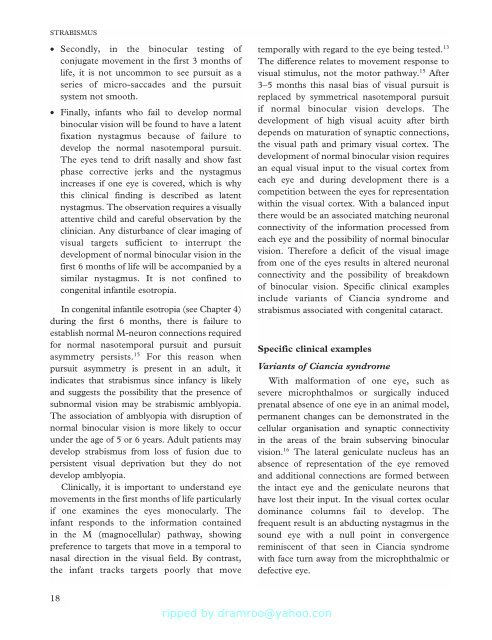Strabismus - Fundamentals of Clinical Ophthalmology.pdf
Strabismus - Fundamentals of Clinical Ophthalmology.pdf
Strabismus - Fundamentals of Clinical Ophthalmology.pdf
You also want an ePaper? Increase the reach of your titles
YUMPU automatically turns print PDFs into web optimized ePapers that Google loves.
STRABISMUS<br />
• Secondly, in the binocular testing <strong>of</strong><br />
conjugate movement in the first 3 months <strong>of</strong><br />
life, it is not uncommon to see pursuit as a<br />
series <strong>of</strong> micro-saccades and the pursuit<br />
system not smooth.<br />
• Finally, infants who fail to develop normal<br />
binocular vision will be found to have a latent<br />
fixation nystagmus because <strong>of</strong> failure to<br />
develop the normal nasotemporal pursuit.<br />
The eyes tend to drift nasally and show fast<br />
phase corrective jerks and the nystagmus<br />
increases if one eye is covered, which is why<br />
this clinical finding is described as latent<br />
nystagmus. The observation requires a visually<br />
attentive child and careful observation by the<br />
clinician. Any disturbance <strong>of</strong> clear imaging <strong>of</strong><br />
visual targets sufficient to interrupt the<br />
development <strong>of</strong> normal binocular vision in the<br />
first 6 months <strong>of</strong> life will be accompanied by a<br />
similar nystagmus. It is not confined to<br />
congenital infantile esotropia.<br />
In congenital infantile esotropia (see Chapter 4)<br />
during the first 6 months, there is failure to<br />
establish normal M-neuron connections required<br />
for normal nasotemporal pursuit and pursuit<br />
asymmetry persists. 15 For this reason when<br />
pursuit asymmetry is present in an adult, it<br />
indicates that strabismus since infancy is likely<br />
and suggests the possibility that the presence <strong>of</strong><br />
subnormal vision may be strabismic amblyopia.<br />
The association <strong>of</strong> amblyopia with disruption <strong>of</strong><br />
normal binocular vision is more likely to occur<br />
under the age <strong>of</strong> 5 or 6 years. Adult patients may<br />
develop strabismus from loss <strong>of</strong> fusion due to<br />
persistent visual deprivation but they do not<br />
develop amblyopia.<br />
<strong>Clinical</strong>ly, it is important to understand eye<br />
movements in the first months <strong>of</strong> life particularly<br />
if one examines the eyes monocularly. The<br />
infant responds to the information contained<br />
in the M (magnocellular) pathway, showing<br />
preference to targets that move in a temporal to<br />
nasal direction in the visual field. By contrast,<br />
the infant tracks targets poorly that move<br />
temporally with regard to the eye being tested. 13<br />
The difference relates to movement response to<br />
visual stimulus, not the motor pathway. 15 After<br />
3–5 months this nasal bias <strong>of</strong> visual pursuit is<br />
replaced by symmetrical nasotemporal pursuit<br />
if normal binocular vision develops. The<br />
development <strong>of</strong> high visual acuity after birth<br />
depends on maturation <strong>of</strong> synaptic connections,<br />
the visual path and primary visual cortex. The<br />
development <strong>of</strong> normal binocular vision requires<br />
an equal visual input to the visual cortex from<br />
each eye and during development there is a<br />
competition between the eyes for representation<br />
within the visual cortex. With a balanced input<br />
there would be an associated matching neuronal<br />
connectivity <strong>of</strong> the information processed from<br />
each eye and the possibility <strong>of</strong> normal binocular<br />
vision. Therefore a deficit <strong>of</strong> the visual image<br />
from one <strong>of</strong> the eyes results in altered neuronal<br />
connectivity and the possibility <strong>of</strong> breakdown<br />
<strong>of</strong> binocular vision. Specific clinical examples<br />
include variants <strong>of</strong> Ciancia syndrome and<br />
strabismus associated with congenital cataract.<br />
Specific clinical examples<br />
Variants <strong>of</strong> Ciancia syndrome<br />
With malformation <strong>of</strong> one eye, such as<br />
severe microphthalmos or surgically induced<br />
prenatal absence <strong>of</strong> one eye in an animal model,<br />
permanent changes can be demonstrated in the<br />
cellular organisation and synaptic connectivity<br />
in the areas <strong>of</strong> the brain subserving binocular<br />
vision. 16 The lateral geniculate nucleus has an<br />
absence <strong>of</strong> representation <strong>of</strong> the eye removed<br />
and additional connections are formed between<br />
the intact eye and the geniculate neurons that<br />
have lost their input. In the visual cortex ocular<br />
dominance columns fail to develop. The<br />
frequent result is an abducting nystagmus in the<br />
sound eye with a null point in convergence<br />
reminiscent <strong>of</strong> that seen in Ciancia syndrome<br />
with face turn away from the microphthalmic or<br />
defective eye.<br />
18










![SISTEM SENSORY [Compatibility Mode].pdf](https://img.yumpu.com/20667975/1/190x245/sistem-sensory-compatibility-modepdf.jpg?quality=85)





